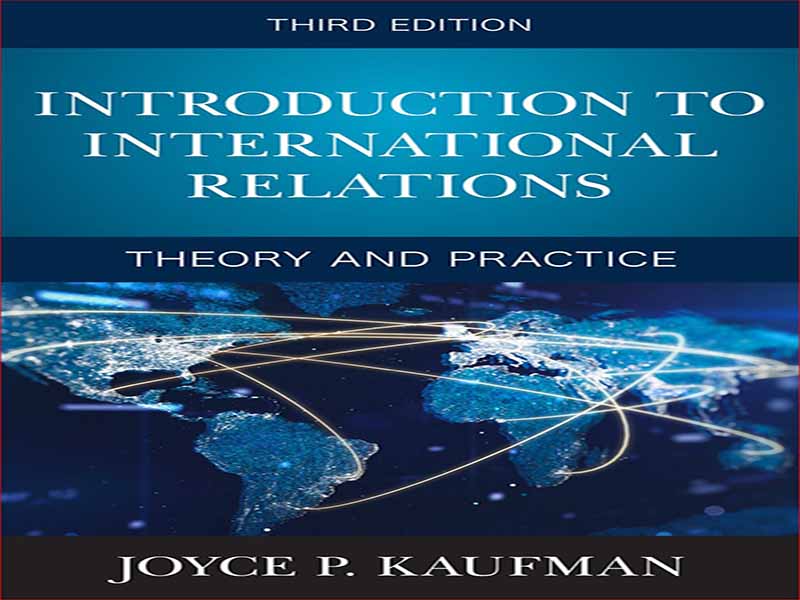- عنوان: Introduction to International Relations
- نویسنده: JOYCE P . KAUFMAN
- حوزه: روابط بین الملل
- سال انتشار: 2022
- تعداد صفحه: 353
- زبان اصلی انگلیسی
- نوع فایل: pdf
- حجم فایل: 2.69 مگابایت
من در ابتدا این مقدمه کوتاه درباره روابط بینالملل را به عنوان پادزهری برای بسیاری از متون بزرگتری که در این موضوع منتشر شده بودند، تهیه کردم. در حالی که در طول سالها از بسیاری از آنها در کلاسهایم استفاده کردم، متوجه شدم که مواد بسیار زیادی برای هضم در مقطع کارشناسی وجود دارد. از این رو، مقدمه چاپ اول این متن را اینگونه آغاز کردم: درک روابط بین الملل (IR) بخش مهمی از آموزش یک دانشجوی مقطع کارشناسی است، چه به عنوان یک برنامه اصلی برنامه علوم سیاسی، چه به عنوان یک دوره مقدماتی در روابط بین الملل/ مسیر مطالعات بین المللی، کلاسی در مورد جهانی شدن، یا صرفاً به عنوان راهنمایی برای درک بهتر دنیایی که در آن زندگی می کند. با این حال، متون روابط بینالملل به طور فزایندهای مملو از جزئیات درباره نظریهها و ایدههایی است که انتزاعی هستند و بهجای اینکه به دانشآموز کمک کنند تئوریها را در «دنیای واقعی» به کار گیرند، از واقعیت حذف شدهاند. من همچنان بر این باورم که این درست است، شاید اکنون بیش از گذشته، به خصوص اگر بتوانیم به طور انتقادی درباره آنچه در اطرافمان می گذرد فکر کنیم و سعی کنیم تأثیر تصمیمات سیاسی را در کوتاه مدت اما درازمدت درک کنیم. به نظر می رسد جهان در حالت هرج و مرج به سر می برد: گرمایش جهانی انواع بلایای زیست محیطی را ایجاد کرده است که به احتمال زیاد متوقف نمی شوند مگر اینکه یا تا زمانی که ما برای معکوس کردن این الگو اقدامی انجام دهیم. شروع جنگ های داخلی به جابجایی مردم و به تبع آن افزایش خصومت نسبت به مهاجران، در مقابل دلسوزی برای مصیبت آنها، کمک کرده است. پایان جنگ در افغانستان در ماه اوت 2021 نه تنها در مورد آینده این کشور و به ویژه زنان در آن، بلکه در مورد اینکه آیا این امر منجر به رشد گروه های تروریستی مانند القاعده و داعش خواهد شد یا خیر، کمک کرده است. که گویا در وهله اول یکی از دلایل آن جنگ بوده است. و غیره در حالی که ممکن است برای کشورها همکاری و مبارزه با چیزی مانند گرمایش جهانی که همه ما را تحت تأثیر قرار می دهد آسان به نظر برسد، دلایلی که چرا چنین نیست ارزش بررسی دارد و دانش آموزان باید به آن فکر کنند. این ویرایش سوم دقیقاً مانند دو نسخه اول سازماندهی شده است: پیرامون سطوح تحلیل و نظریه ها و بازیگران اصلی حاکم بر حوزه روابط بین الملل. با این حال، من همچنین کتاب را به روز کرده ام تا شامل بخشی در مورد نقش رسانه ها به عنوان یک بازیگر غیردولتی باشد که نقش مهمی فزاینده ای در گفتمان سیاسی جاری داشته است، و بخشی در مورد جامعه مدنی، که همچنین نقش مهمی را ایفا کرده است. نقش در رفتار ملت ها بخش دیگری در مورد نقش ادراکات در روابط بینالملل گنجاندهام، زیرا همانطور که اغلب به دانشجویانم گفتهام، «ادراکات به واقعیت تبدیل میشوند». و من یک مورد جدید را در فصل 6 در مورد زنان، صلح و امنیت، و همچنین سه مورد دیگر را به طور قابل توجهی به روز کردم و دوباره کار کردم. من فکر می کنم که نتیجه مطالعه به روز شده محیط بین المللی فعلی است.
I initially drafted this short introduction to international relations as an antidote to many of the larger texts that were out on the topic. While I used many of them in my classes over the years, I found that they had too much material for undergraduates to digest. Hence, I started the preface to the first edition of this text this way: Understanding international relations (IR) is an important part of an undergraduate student’s education, whether as a staple of a political science program, an introductory course in an international relations/international studies track, a class on globalization, or simply as a guide to better understand the world in which he or she lives. Yet, increasingly, international relations texts are chock full of details about theories and ideas that are abstract and seen as removed from reality rather than helping the student apply the theories to the “real world.” I continue to believe that this is true, perhaps more so now than previously, especially if we are to be able to think critically about what is going on around us and try to understand the impact of policy decisions in the short but also longer term. The world seems to be in a state of chaos: global warming has created all sorts of environmental disasters that are not likely to stop unless or until we take action to reverse the pattern; the onset of civil wars has contributed to the movement of people and, with that, increasing hostility toward immigrants, as opposed to compassion for their plight; the end of the war in Afghanistan in August 2021 has contributed to further uncertainty not only about the future of that state and especially the women within it, but as to whether it will lead to a growth of terrorist groups such as al-Qaeda and ISIS, which was allegedly one of the reasons for that war in the first place; and so on. While it might seem easy for countries to work together and fight something like global warming, which affects all of us, the reasons why that is not the case are worth exploring and that students should be thinking about. This third edition is organized much as the first two were: around levels of analysis and the major theories and actors that govern the field of international relations. However, I have also updated the book to include a section on the role of the media as a nonstate actor that has taken an increasingly important part in the current political discourse, and a section on civil society, which has also come to play an important role in nations’ behavior. I included another section on the role of perceptions in international relations because, as I have often told my students, “perceptions become reality.” And I added a new case in chapter 6 on the women, peace, and security agenda, as well as significantly updating and reworking the other three cases. I think that the result is an updated study of the current international environment.
این کتاب را میتوانید بصورت رایگان از لینک زیر دانلود نمایید.
Download: Introduction to International Relations




































نظرات کاربران